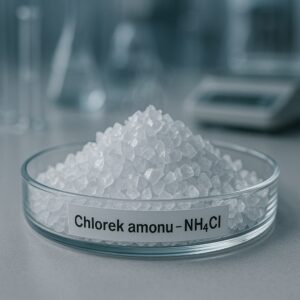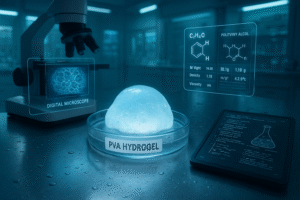Acrylamide is a reactive, colorless monomer used on a massive scale in the synthesis of polyacrylamides and other engineering polymers. Its presence in a wide range of sectors – from water treatment to mining to biological laboratories – makes it an extremely important ingredient in modern industrial chemistry. Despite the need for special care in its use, it is a compound of great technological and economic importance.
Find out what characterizes acrylamide, where it is used and its key chemical properties.
Technical data
- Chemical name: Acrylamide
- CAS number: 79-06-1
- EC (EINECS) Number: 201-173-7
- Sum formula: C3H5NO
- Molar mass: 71.08 g/mol
- Physical form: Colorless, hygroscopic crystals
- Solubility: Very good in water, alcohol and acetone
- Melting point: 84-85 °C
- Boiling point: 125 °C (decomposition)
Industrial applications
1. water and wastewater treatment
Acrylamide is used to produce polyacrylamide, which acts as a flocculant in water treatment. It makes it possible to quickly and efficiently remove suspended solids in treatment plants and water supply systems. This application is found in household chemicals.
2. mining and construction industry
In the mining and soil engineering sectors, acrylamide polymers are used to fill rock voids, improve soil stability and seal. They are also used as additives in drilling muds and process fluids.
3. paper and textile production
In the paper industry, acrylamide is used to improve fiber retention and strength of wet products. In the textile industry – as a component of impregnating agents and improving the durability of dyes.
4. biotechnology and electrophoresis
High-purity acrylamide is used in molecular biology to prepare polyacrylamide gels (PAGE), which are used to separate proteins and nucleic acids. It is a standard technique in DNA, RNA and protein analysis.
Chemical properties and safety
- Reactivity: readily polymerizes when exposed to UV or radical initiators
- The product requires the use of inhibitors (e.g., hydroquinone) to stabilize the
- At room temperature it is stable, but requires protection from light and moisture
- Toxic product – suspected of carcinogenic, neurotoxic and mutagenic effects
The use of acrylamide must be carried out under strictly controlled conditions, with full protective equipment: mask with filter, nitrile gloves, apron, goggles. Work should take place in a fume hood.
Chemical curiosities
- Acrylamide is also formed naturally – as a byproduct of heat treatment (above 120°C) of foods containing starch and asparagine.
- It was first synthesized in 1893 by German chemist Bertram.
- Used as a raw material for hydrogels – absorbent materials in diapers, dressings and contact lenses.
Summary
Acrylamide is a key monomer with versatile applications ranging from water treatment to the mining industry to biological laboratories. Its high reactivity makes it an extremely useful material, but one that also requires a responsible approach. Check out the full product range at vichemic.co.uk/offer/business-chemistry/acrylamide.
Zobacz także

Cetylostearyl alcohol – emollient makes creams velvety
Cetylostearyl alcohol, also known as C16-18 alcohol, is a mixture of cetyl and stearyl – fatty alcohols with a creamy consistency. Although at first glance it looks like a transparent waxy substance, its applications are the essence of luxury and functionality in cosmetics and pharmaceuticals. It goes into lotions, mousses and targeted medical formulas, where […]
Read more 
Ammonium chloride (salmiak) – a versatile chemical compound of industrial importance
Ammonium chloride, also known as salmiak, is one of the oldest and most widely used chemical compounds in industry, agriculture, pharmaceuticals and laboratories. This white, crystalline powder with a slightly salty taste and high hygroscopicity hides enormous technological potential – from nitrogen fertilizers to electrodes in zinc-carbon batteries. Vichemic offers – Ammonium Chloride is available […]
Read more 
Polyvinyl alcohol – a modern polymer for industry, medicine and ecology
Polyvinyl alcohol (PVA) is a synthetic, water-soluble polymer with exceptional versatility. Its physicochemical properties – including its ability to form films, high viscosity, biocompatibility and non-toxicity – make it used in dozens of industries: from pharmaceuticals and cosmetics to construction and eco-friendly production of water-soluble packaging. Vichemic – Polyvinyl alcohol offers a raw material with […]
Read more 

